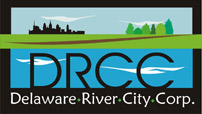Philadelphia City Paper
by Daniel Campo
Sarah Thorp considers the city’s waterfront north of Penn’s Landing “one of Philadelphia’s best-kept secrets,” even though she realizes, “You’re not going to get there unless you know how to get there.”
“It’s ridiculously beautiful,” she says of the 10 fragmented miles of waterfront stretching from Allegheny Avenue north past active chemical refineries, factories, distribution centers, garbage transfer stations, industrial ruins, polluted inlets and superfund sites. But hidden amid this vast array of industry and wasteland are several places to experience the Delaware River’s nature and beauty, including Pleasant Hill Park, Pennypack Park on the Delaware, two public boat launches, numerous informal spots and the serene Glen Foerd estate. Thorp, executive director of the Delaware River City Corporation (DRCC), began at the fledgling nonprofit in October after earning a master’s degree in historic preservation at the University of Pennsylvania and serving 10 years as a Navy pilot. As the DRCC’s only full-time employee, she’s an “army of one,” leading the implementation of the North Delaware Riverfront Greenway.
While the Central Delaware Waterfront planning process, led by PennPraxis, has garnered most of the public attention and excitement, and the two planned riverfront casinos in Fishtown and South Philadelphia most of the controversy, this effort will likely produce public amenities on the North Delaware long before anything happens to the south. “Our goal is to add to and connect the existing waterfront park spaces,” she says, “and then connect them back to the neighborhoods.” The plan capitalizes on public-owned areas where the trail can be developed and knitted together using additional land purchases and easements over private properties. It also calls for the development of “green connector streets” to be improved with various combinations of new plantings, sidewalks, bike lanes, lighting and signage. This part of the plan is crucial, since most of the adjacent neighborhoods are largely cut off from the water’s edge by I-95, the Northeast Corridor train tracks, various industrial plants and, in one section, a prison and detention center.
Armed with a $1 million grant from the Pennsylvania Department of Conservation and Natural Resources, Thorp will oversee the construction of the first two sections of the greenway: a two-thirds-of-a-mile extension to the Pennypack Park Trail to begin this summer; and in the fall, the transformation of a five-acre tangle of concrete, weeds and fencing at the foot of the Tacony-Palmyra Bridge into Lardner’s Point Park. Both projects will be ready for public use in early 2008. The Greenway Plan is part of a larger effort to redevelop more than 700 acres of vacant or underutilized riverfront property into thousands of units of housing, commercial space and parks over the coming decades. Implementation of the plan’s recreation trail — to run the entire length of the northern riverfront — is being done in concert with private developers who are moving forward with large-scale master plans for residential communities at four different brownfield sites. Construction on two of these communities may begin as early as summer.
While the goals and larger strategies are relatively simple, the challenges are complex and numerous. In addition to the obvious need for environmental remediation in places where 150 years of accumulated waste have degraded the land, logistical, legal and economic issues complicate matters. The properties lining the river are a jumble of public and privately owned parcels. The middle stretch of the trail through Bridesburg, Wissinoming and Tacony will capitalize on the city’s recent purchase of the former Kensington and Tacony Railroad right-of-way. But through these sections, the trail will pass several active industrial operations, including the Sunoco and Rohm and Haas chemical plants, and deal with their security concerns. In other sections, the right-of-way has been unofficially claimed by adjacent businesses. Then, in the section that runs through Holmesburg, the trail will be routed past a private firing range and inland around the massive water treatment facility that intakes and filters 50 percent of the city’s water supply. (Post-9/11 security issues will require greater separation between the trail and the treatment plant.) Farther north in Torresdale, the trail must detour well inland around two gated waterfront communities developed in the 1980s, which have no legal obligation or present incentive to provide public access to the river.
So, Thorp spends much of her time meeting with property owners to gain easements for the trail or assure them that the presence of hikers and bikers will pose no threat to the success of continued operations. She also meets with numerous private and public organizations, trying to build constituencies for the trail’s eventual use and maintenance and raise funds for its development. For someone who used to land jets on aircraft carriers in the middle of the ocean, Thorp concedes that this may be her greatest challenge.
“Come back in just five years when most of the trail will be complete,” she says. “It’s going to be a huge transformation!”
